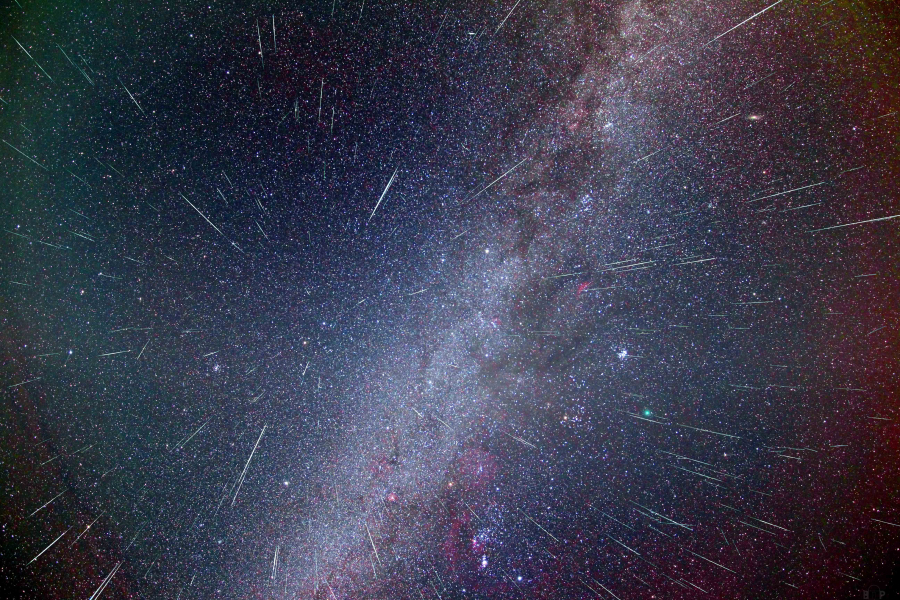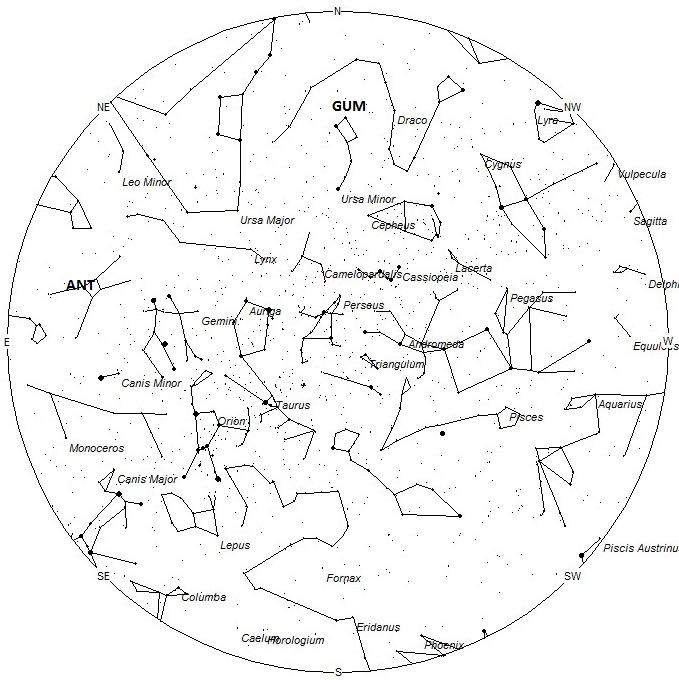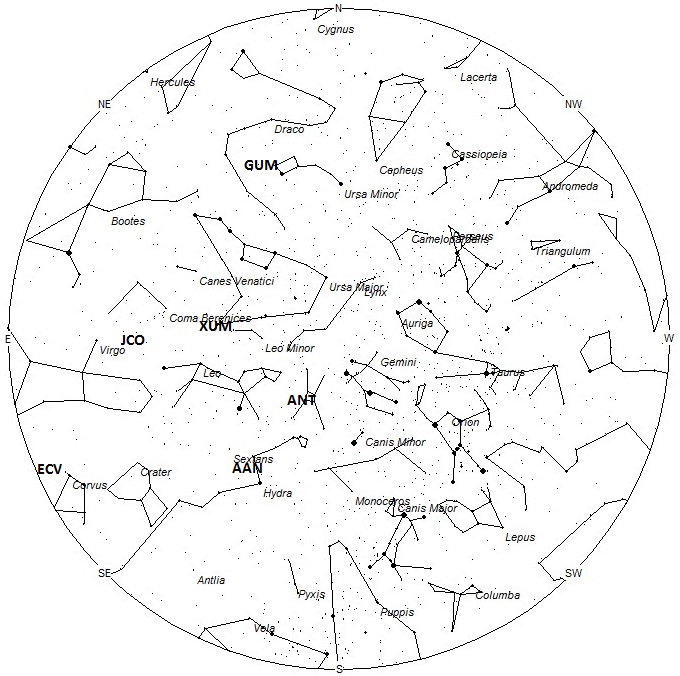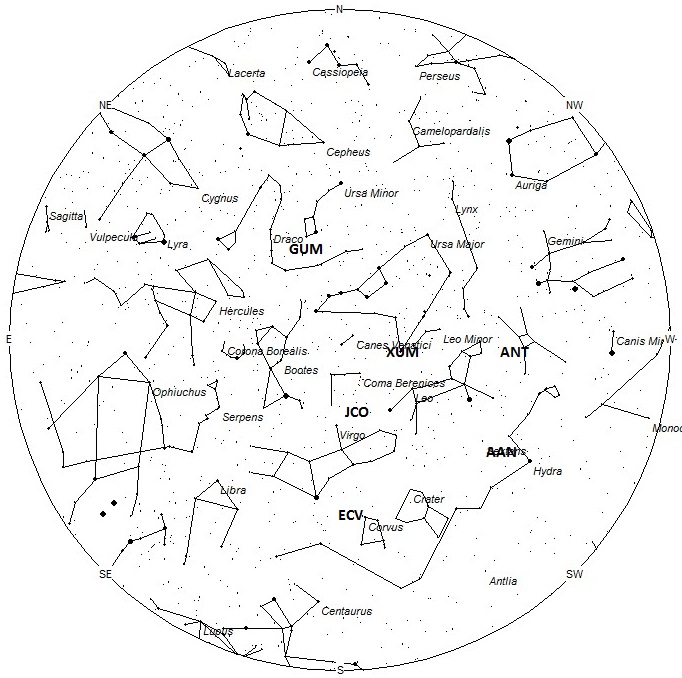 Ugo Bartole was photographing the Geminid meteor shower on the night of December 13/14, 2018, from the dark skies near Capital Reef, Utah. He used a Canon EOS-M2 with Super-wide angle lens and captured 274 meteors from 128 photos. All meteors are in their correct positions. Also notice the greenish comet 46P/Wirtanen on the right side of the photo to the lower right of the Pleiades. © Ugo Bartole
Ugo Bartole was photographing the Geminid meteor shower on the night of December 13/14, 2018, from the dark skies near Capital Reef, Utah. He used a Canon EOS-M2 with Super-wide angle lens and captured 274 meteors from 128 photos. All meteors are in their correct positions. Also notice the greenish comet 46P/Wirtanen on the right side of the photo to the lower right of the Pleiades. © Ugo Bartole
During this period the moon will reach its full phase on Monday January 21st. At this time the moon will be located opposite the sun and will lie above the horizon all night long as seen from mid-northern latitudes. The bright moon will make viewing meteor activity difficult during this entire period. Hourly meteor rates for evening observers this week is near 2 no matter your location. The rates for morning observers will be near 5 no matter your location. The actual rates will also depend on factors such as personal light and motion perception, local weather conditions, alertness and experience in watching meteor activity. Rates are reduced due to interfering moonlight. Note that the hourly rates listed below are estimates as viewed from dark sky sites away from urban light sources. Observers viewing from urban areas will see less activity as only the brighter meteors will be visible from such locations.
The radiant (the area of the sky where meteors appear to shoot from) positions and rates listed below are exact for Saturday night/Sunday morning January 19/20. These positions do not change greatly day to day so the listed coordinates may be used during this entire period. Most star atlases (available at science stores and planetariums) will provide maps with grid lines of the celestial coordinates so that you may find out exactly where these positions are located in the sky. A planisphere or computer planetarium program is also useful in showing the sky at any time of night on any date of the year. Activity from each radiant is best seen when it is positioned highest in the sky, either due north or south along the meridian, depending on your latitude. It must be remembered that meteor activity is rarely seen at the radiant position. Rather they shoot outwards from the radiant so it is best to center your field of view so that the radiant lies near the edge and not the center. Viewing there will allow you to easily trace the path of each meteor back to the radiant (if it is a shower member) or in another direction if it is a sporadic. Meteor activity is not seen from radiants that are located far below the horizon. The positions below are listed in a west to east manner in order of right ascension (celestial longitude). The positions listed first are located further west therefore are accessible earlier in the night while those listed further down the list rise later in the night.
These sources of meteoric activity are expected to be active this week.
Descriptions of each source will continue next week when viewing conditions improve.
| SHOWER | DATE OF MAXIMUM ACTIVITY | CELESTIAL POSITION | ENTRY VELOCITY | CULMINATION | HOURLY RATE | CLASS |
| RA (RA in Deg.) DEC | Km/Sec | Local Standard Time | North-South | |||
| Anthelion (ANT) | – | 08:48 (132) +18 | 30 | 01:00 | 2 – 1 | II |
| alpha Antliids (AAN) | Feb 01 | 09:48 (147) -05 | 45 | 02:00 | <1 – <1 | IV |
| January xi Ursae Majorids (XUM) | Jan 18 | 11:22 (171) +32 | 41 | 04:00 | <1 – <1 | IV |
| January Comae Berenicids (JCO) | Jan 24 | 12:36 (189) +16 | 64 | 05:00 | <1 – <1 | IV |
| eta Corvids (ECV) | Jan 22 | 12:42 (190) -17 | 68 | 05:00 | <1 – <1 | IV |
| gamma Ursae Minorids (GUM) | Jan 18 | 15:08 (227) +67 | 30 | 08:00 | <1 – <1 | IV |
 American Meteor Society
American Meteor Society



I remember an amazing Leonids show from Colossal Cave park, South East of Tucson, AZ. I do not remember what year it was. I know it was between 2000 and 2003. Where can i look up information to find what heard it was ? Thanks !
– t
Hi Tom and All,
That would have been November 18, 2001. It remember that display too as I was on the peak of Mt. Lemmon, not too far from you on that morning.